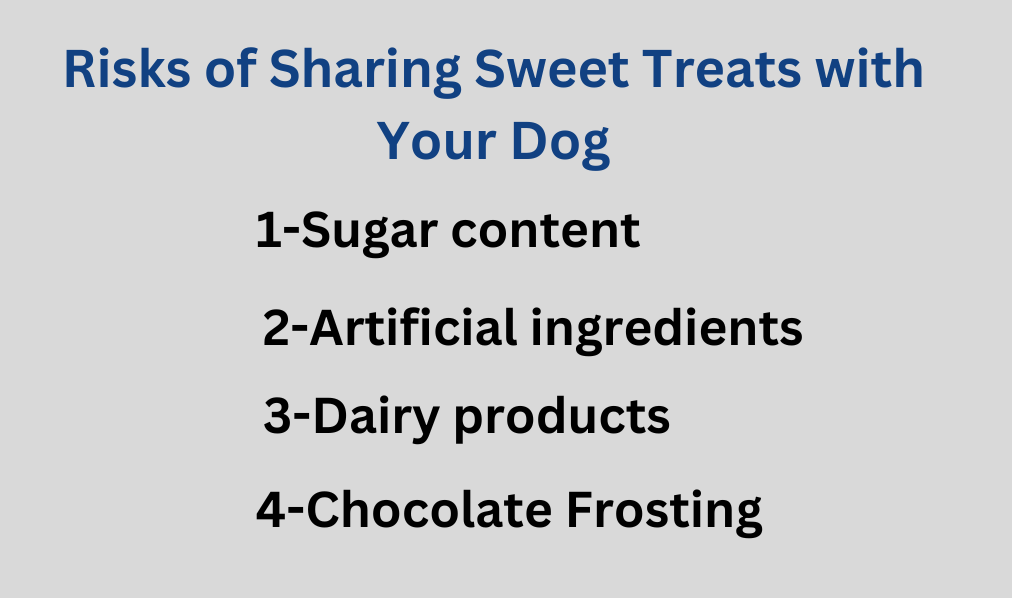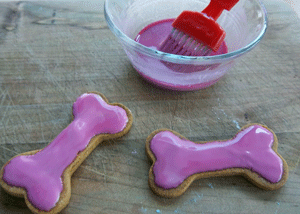Have you ever wondered if you can share your delicious frosting with your furry friend? If you are a dog lover and a cake lover, you might be tempted to give your dog a taste of your sweet treat. But can dogs eat frosting? Is frosting good for dogs? Can it harm them or make them sick? In this article, we will answer these questions and more that are beneficial for your dog.
We will explore the dangers of feeding your dog regular frosting, the benefits of feeding your dog homemade frosting, and the best occasions to treat your dog with frosting. By the end of this blog post, you will know how to make your dog happy and healthy with frosting, without compromising their nutrition or wellness.
Can Dogs Eat Frosting? Learn the Risks of Sharing Sweet Treats with Your Furry Friend
Frosting may look tempting and tasty, but can dogs eat frosting? So, It is not a good treat for your dog. Frosting is made of sugar, butter, milk, cream, and sometimes other ingredients that are harmful or unhealthy for your dog. Here are some reasons why regular frosting is bad for dogs and how it can harm their health.
Sugar content
The main ingredient in frosting is sugar, which is not good for your dog. Sugar can cause a host of problems from tooth decay, and diabetes, to obesity and more.
Eating sugar can also cause digestive upsets in dogs, which can include vomiting and diarrhea. Sugar can also affect your dog’s mood and behavior, making them hyperactive, restless, or aggressive.
Artificial ingredients
Some frostings may contain artificial ingredients, such as colors, flavors, preservatives, or sweeteners. These ingredients can be toxic or allergenic for your dog, causing reactions such as skin rashes, itching, swelling, or breathing difficulties.
Some artificial sweeteners, such as xylitol, can be deadly for dogs, as they can cause a sudden drop in blood sugar, seizures, liver failure, or even death.
Dairy products
Frosting also contains dairy products, such as butter, milk, or cream. While some dogs can tolerate small amounts of dairy, others may be lactose intolerant or allergic to dairy proteins. This means that they cannot digest dairy properly, leading to gas, bloating, cramps, or diarrhea.
Dairy products can also cause inflammation, mucus production, or ear infections in some dogs. This means that they cannot digest dairy properly, leading to gas, bloating, cramps, or diarrhea. Dairy products can also cause inflammation, mucus production, or ear infections in some dogs.
Chocolate Frosting
Can dogs eat chocolate frosting? Many pet owners think about it. Chocolate is another ingredient that may be found in some frostings, especially if they are chocolate-flavored or have chocolate chips.
Chocolate is toxic for dogs, as it contains caffeine and theobromine, which are stimulants that can affect your dog’s nervous system, heart, and kidneys. Depending on the amount and type of chocolate, your dog may experience symptoms such as vomiting, diarrhea, tremors, seizures, or even chocolate frosting kill a dog.
How to avoid or limit your dog’s exposure to regular frosting
As you can see, regular frosting is not a safe or healthy treat for your dog. Here are some tips on how to avoid or limit your dog’s exposure to regular frosting:
- Keep your frosting and any frosted treats out of your dog’s reach, such as in a closed cabinet, a high shelf, or a locked container.
- Read the labels of any store-bought or homemade frosting and avoid any ingredients that are harmful or unhealthy for your dog, such as sugar, artificial sweeteners, chocolate, or dairy products.
- Choose dog-friendly alternatives to regular frosting, such as plain Greek yogurt, peanut butter, pumpkin, or cream cheese, and use them sparingly and occasionally.
- Make your safe frosting for dogs with natural and healthy ingredients, such as cooked tapioca starch, plain Greek yogurt, and water. You can also add some natural colors or flavors with pureed fruits or vegetables, such as cranberries, strawberries, or parsley.
- Monitor your dog for any signs of illness or discomfort after they eat any frosting or frosted treats, and contact your veterinarian.
The benefits of feeding your dog homemade frosting
Frosting may seem like a guilty pleasure, but it can also be a healthy treat for your dog. Homemade frosting is better for dogs than regular frosting, as it contains natural ingredients, lower sugar content, and customized flavors. Here are some reasons why homemade frosting is good for dogs and how it can improve their health.
Natural ingredients
Homemade frosting is made with natural ingredients and it is a safe topping for dogs, such as yogurt, tapioca starch, and water. These ingredients are safe and healthy for your dog, as they provide protein, calcium, and probiotics.
Probiotics are beneficial bacteria that help your dog’s digestion and immunity. You can also add natural colors and flavors to your homemade frosting with pureed fruits or vegetables, such as cranberries, strawberries, or parsley. These ingredients are rich in antioxidants, vitamins, and minerals that support your dog’s overall health.
Lower sugar content
Homemade frosting is lower in sugar than regular frosting, as it does not contain any added sugar or artificial sweeteners. Sugar can cause many problems for your dog, such as tooth decay, diabetes, obesity, and more. Artificial sweeteners can be toxic or allergenic for your dog, causing reactions such as skin rashes, itching, swelling, or breathing difficulties.
By making your frosting, you can control the amount and type of sugar you use, and avoid any harmful ingredients. You can also use natural sweeteners, such as honey, maple syrup, or molasses, which have some nutritional benefits for your dog.
Customized flavors
Homemade frosting is customized to your dog’s preferences, as you can choose the flavors and ingredients that your dog likes. You can experiment with different combinations of yogurt, fruits, vegetables, herbs, spices, and more.
You can also make different types of frosting, such as cream cheese, peanut butter, pumpkin, or cream cheese. You can tailor your frosting to your dog’s dietary needs, such as gluten-free, grain-free, or dairy-free. You can also make your frosting more fun and festive by adding toppings, such as sprinkles, coconut flakes, or nuts.
How to make your homemade frosting
Making your homemade frosting is easy and fun. A few materials and a short amount of time are all you need. Here are some tips on how to make your homemade frosting:
- Choose a base for your frosting, such as yogurt, cream cheese, peanut butter, or pumpkin. You can use plain or flavored yogurt, but make sure it does not contain sugar or artificial sweeteners1. You can also use low- or non-fat yogurt or cream cheese to reduce the calories and fat in your frosting.
- Choose a thickener for your frosting, such as tapioca starch, potato starch, rice flour, or arrowroot starch. These ingredients help your frosting harden and hold its shape. You can cook the starch with water until it forms a paste, or use it raw and mix it with the base.
- Choose a color and flavor for your frosting, such as pureed fruits or vegetables, natural food coloring, or extracts. You can use any fruits or vegetables that are safe and healthy for your dog, such as cranberries, strawberries, or parsley. You can also use natural food coloring from a health food store, or extracts such as vanilla, almond, or lemon.
- Mix the ingredients in a small bowl until you get the consistency of frosting. You can adjust the amount of water, milk, or juice you add to make your frosting thinner or thicker. You can also add some natural sweeteners, such as honey, maple syrup, or molasses if you want to make your frosting sweeter.
- Decorate your dog’s treats with your homemade frosting. You can use a knife, a spatula, a piping bag, or a ziplock bag with a corner cut-off to apply your frosting. You can also dip your treats into the frosting, or drizzle it over them. You can add some toppings, such as sprinkles, coconut flakes, or nuts, to make your treats more attractive and tasty.
- Let your frosting harden on your treats before serving them to your dog. You can place your treats on wax paper or parchment paper and let them dry at room temperature, or refrigerate them for faster results. You can store your treats in an airtight container in the refrigerator for up to a week, or in the freezer for up to a month.
The best occasions to treat your dog with frosting
Frosting is not a regular food for dogs, but a special treat that should be given sparingly and occasionally. Frosting can enhance your dog’s happiness, but it can also cause health problems if given too often or in large amounts.
Here are some reasons why frosting is a special treat for dogs and how to balance it with their normal diet.
Why frosting is a special treat for dogs
Frosting is a special treat for dogs because it is not part of their natural or balanced diet. Dogs do not need sugar, dairy, or other ingredients that are commonly found in frosting.
These ingredients can cause digestive issues, dental problems, weight gain, cardiac problems, diabetes, and a shorter lifespan. Frosting should be given as a rare and occasional treat, not as a regular or daily food.
Frosting is also a special treat for dogs because it is a way to show your love and appreciation for your dog. Dogs love to eat, and they love to eat something tasty and different from their usual food.
Can dogs eat frosting? Frosting can make your dog feel happy, special, and rewarded. Frosting can also be a way to celebrate your dog’s milestones, such as birthdays, adoption days, training achievements, or recovery from illness.
How to balance frosting with your dog’s normal diet
To balance frosting with your dog’s normal diet, you need to follow some guidelines and precautions. Here are some tips on how to balance frosting with your dog’s normal diet:
- Choose a healthy and dog-friendly frosting recipe, such as the ones I suggested in the previous points. Avoid any ingredients that are harmful or unhealthy for your dog, such as sugar, artificial sweeteners, chocolate, or dairy products.
- Limit the amount and frequency of frosting you give to your dog. Frosting should be no more than 10% of your dog’s daily calorie intake and should be given no more than once a week. You can use a calorie calculator to determine how much frosting your dog can have based on their weight, age, and activity level.
- Reduce the amount of your dog’s regular food on the day you give them frosting. This will help prevent overfeeding and weight gain. You can also increase your dog’s exercise on the day you give them frosting to burn off some extra calories.
- Monitor your dog for any signs of illness or discomfort after they eat frosting. Some dogs may have allergies, intolerances, or sensitivities to some ingredients in frosting. If you notice any symptoms, such as vomiting, diarrhea, itching, swelling, or breathing difficulties, stop giving your dog frosting and contact your veterinarian.
How to make the most of your dog’s frosting experience
To make the most of your dog’s frosting experience, you need to make it fun and memorable. Here are some tips on how to make the most of your dog’s frosting experience:
- Choose the right size, shape, and color for your dog’s treats. You can use different sizes and shapes of cookie cutters, molds, or pans to make your treats. You can also use natural food colors to make your frosting more appealing and festive.
- Add some toppings to your dog’s treats. You can use some safe and healthy toppings, such as sprinkles, coconut flakes, or nuts, to make your treats more attractive and tasty. You can also use some fruits, vegetables, herbs, or spices to add some extra flavor and nutrition to your treats.
- Take some photos of your dog’s treats and your dog enjoying them. You can capture some precious moments of your dog’s happiness and share them with your friends and family. You can also use some props, such as hats, balloons, or banners, to make your photos more fun and festive.
- Enjoy the moment with your dog. You can use frosting as a way to bond with your dog and show them how much you love them. You can praise your dog, cuddle with them, play with them, or just watch them enjoy their treat. You can also join them in eating some frosting, as long as it is safe and healthy for both of you.
Can I give frosting to puppies or senior dogs?
I see that you have a question can dogs eat frosting? And it is safe for puppies or senior dogs. Frosting is a sweet and creamy topping that is often used for cakes, cupcakes, or other desserts. Frosting can be tempting for dogs, but it is not a healthy or safe treat for them. Here are some reasons why you should avoid or limit giving frosting to puppies or senior dogs:
- Frosting contains sugar, dairy, and other ingredients that are harmful or unhealthy for dogs. Sugar can cause tooth decay, diabetes, obesity, and other health problems in dogs1. Dairy can cause digestive issues, allergies, or inflammation in dogs, especially if they are lactose intolerant or allergic to dairy proteins.
- Other ingredients, such as artificial colors, flavors, preservatives, or sweeteners, can be toxic or allergenic for dogs, causing reactions such as skin rashes, itching, swelling, or breathing difficulties. Some frostings may also contain chocolate, which is poisonous for dogs, as it contains caffeine and theobromine, which are stimulants that can affect your dog’s nervous system, heart, and kidneys.
- Puppies and senior dogs are more vulnerable and sensitive to frosting than adult dogs. Puppies have immature digestive systems and immune systems, which make them more prone to gastrointestinal problems, infections, or allergies from frosting.
- Senior dogs have weaker digestive systems and immune systems, which make them more susceptible to chronic diseases, such as diabetes, obesity, or arthritis, from frosting. Puppies and senior dogs also have weaker teeth and gums, which make them more likely to suffer from dental problems, such as cavities, plaque, or gum disease, from frosting.
- Frosting is not a balanced or nutritious food for dogs. Frosting does not provide any essential nutrients, such as protein, fat, fiber, vitamins, or minerals, that dogs need for their growth, development, and maintenance.
Frosting only provides empty calories, which can lead to weight gain, malnutrition, or nutrient deficiencies in dogs. Frosting can also interfere with your dog’s normal diet, as it can reduce their appetite, spoil their taste buds, or cause them to reject their regular food.
Healthier and safer alternatives of frosting for dogs
Therefore, frosting is not a good treat for puppies or senior dogs, and it should be avoided or limited as much as possible. If you want to treat your puppy or senior dog with something sweet and creamy, you can choose some healthier and safer alternatives, such as:
- Plain yogurt: is a good source of protein, calcium, and probiotics for dogs. You can use plain or flavored yogurt, but make sure it does not contain sugar or artificial sweeteners. You can also use low- or non-fat yogurt to reduce the calories and fat in your treat.
- Peanut butter: is a good source of protein, healthy fats, and antioxidants for dogs. You can use natural or organic peanut butter, but make sure it does not contain sugar, salt, or xylitol, which is a deadly artificial sweetener for dogs. You can also use unsalted or low-sodium peanut butter to reduce the sodium in your treat.
- Pumpkin: is a good source of fiber, beta-carotene, and vitamin A for dogs. You can use canned or fresh pumpkin, but make sure it is pure and not mixed with sugar, spices, or other ingredients. You can also use cooked or pureed pumpkin to make it easier for your dog to eat.
You can use these alternatives as a base for your homemade frosting, and add some natural colors or flavors with pureed fruits or vegetables, such as cranberries, strawberries, or parsley. You can also use some natural sweeteners, such as honey, maple syrup, or molasses, to make your frosting sweeter.
You can mix the ingredients in a small bowl until you get the consistency of frosting, and decorate your dog’s treats with it. You can also use some safe and healthy toppings, such as sprinkles, coconut flakes, or nuts, to make your treats more attractive and tasty.
However, even if you use these healthier and safer alternatives, you should still give frosting to your puppy or senior dog sparingly and occasionally, as it is not a regular or daily food for them. Frosting should be no more than 10% of your dog’s daily calorie intake and should be given no more than once a week.
You can use a calorie calculator to determine how much frosting your dog can have based on their weight, age, and activity level. You should also reduce the amount of your dog’s regular food on the day you give them frosting, to prevent overfeeding and weight gain. You should also increase your dog’s exercise on the day you give them frosting, to burn off some extra calories.
You should also monitor your dog for any signs of illness or discomfort after they eat frosting, and contact your veterinarian if you notice any symptoms, such as vomiting, diarrhea, itching, swelling, or breathing difficulties.
Some dogs may have allergies, intolerances, or sensitivities to some ingredients in frosting, and may react differently to them. You should also consult your veterinarian before giving frosting to your puppy or senior dog, especially if they have any health conditions, such as diabetes, obesity, or kidney disease, that may require a special diet or medication.
How can I store leftover frosting for my dog?
For storing leftover frosting, it depends on the type of frosting and how long you want to keep it. Here are some general suggestions:
- If you plan to use the frosting within a week, you can store it in the refrigerator in an airtight container. This will prevent it from drying out or absorbing odors from other foods.
- If you have a large amount of frosting or want to store it for longer, you can freeze it in an airtight container. This will preserve its taste and texture for up to three months. However, not all frostings freeze well, so you should check the specific recipe before freezing. Buttercream and cream cheese frostings usually freeze better than whipped cream or meringue-based frostings.
- When you want to use the frosting again, you should thaw it in the refrigerator overnight, then let it come to room temperature and stir it gently to restore its smoothness. You may need to adjust the sweetness or consistency by adding more sugar or liquid if needed.
- You can find more information and tips on how to store frosting in the web search results.
Conclusion
In this piece of knowledge, We have learned about whether can dogs eat frosting? and what kind of frosting is safe and healthy for them.
We have explored the dangers of feeding your dog regular frosting, the benefits of feeding your dog homemade frosting, and the best occasions to treat your dog with frosting.
We have also shared some tips and recipes on how to make your dog-friendly frosting with natural and healthy ingredients.
We hope you have enjoyed this blog post and learned something new and useful. If you want to make your dog happy and healthy with frosting, here are some action steps you can take:
- Try out some of the recipes we suggested, or create your own with your favorite ingredients.
- Share your feedback and photos with us in the comments section below, or on our social media pages.
- Subscribe to our blog to get more tips and tricks on dog nutrition and wellness.
- Share this blog post with your friends and family who have dogs, or who love frosting.
Thank you for reading this blog post and for being a part of our community. We appreciate your support and love for your dog. Remember, frosting is not a regular food for dogs, but a special treat that should be given sparingly and occasionally. Frosting can make your dog happy, but it can also make them sick if given too often or in large amounts. So, be careful and responsible when you treat your dog with frosting, and enjoy the moment with them.
FAQs About Can Dogs Eat Frosting
Q: Can dogs eat frosting?
A: No, regular frosting is not safe for dogs. It contains harmful ingredients like sugar, artificial sweeteners, chocolate, and dairy, which can lead to various health issues, including digestive problems, toxicity, and allergies.
Q: What are the dangers of feeding dogs regular frosting?
A: The main dangers include the high sugar content leading to tooth decay and obesity, potential ingestion of artificial ingredients causing toxic reactions, dairy products causing digestive issues, and the toxicity of chocolate if present in the frosting.
Q: Is homemade frosting safe for dogs?
A: Yes, homemade frosting can be a healthier option for dogs. It allows you to control ingredients, use natural and dog-friendly alternatives like yogurt or peanut butter, and avoid harmful additives present in regular frosting.
Q: How can I avoid exposing my dog to regular frosting?
A: Keep frosting out of reach, read labels for harmful ingredients, opt for dog-friendly alternatives like yogurt or peanut butter, and consider making your frosting using natural and healthy ingredients.
Q: Can puppies or senior dogs have frosting?
A: It’s not recommended to give frosting to puppies or senior dogs due to their vulnerability. Frosting contains ingredients that may harm their developing or weakened systems. Healthier alternatives like plain yogurt, peanut butter, or pumpkin can be considered sparingly and in moderation.








